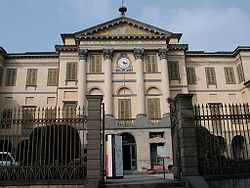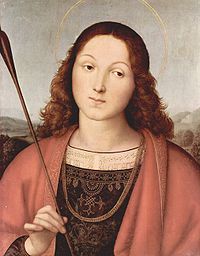
Accademia Carrara
Encyclopedia

Art gallery
An art gallery or art museum is a building or space for the exhibition of art, usually visual art.Museums can be public or private, but what distinguishes a museum is the ownership of a collection...
and an academy
Academy
An academy is an institution of higher learning, research, or honorary membership.The name traces back to Plato's school of philosophy, founded approximately 385 BC at Akademia, a sanctuary of Athena, the goddess of wisdom and skill, north of Athens, Greece. In the western world academia is the...
of fine arts in Bergamo
Bergamo
Bergamo is a town and comune in Lombardy, Italy, about 40 km northeast of Milan. The comune is home to over 120,000 inhabitants. It is served by the Orio al Serio Airport, which also serves the Province of Bergamo, and to a lesser extent the metropolitan area of Milan...
, Italy
Italy
Italy , officially the Italian Republic languages]] under the European Charter for Regional or Minority Languages. In each of these, Italy's official name is as follows:;;;;;;;;), is a unitary parliamentary republic in South-Central Europe. To the north it borders France, Switzerland, Austria and...
.
History
The origins of the art gallery lie with the Count Giacomo Carrara, a wealthy collector and patron of the arts, who left a generous legacy to the city of Bergamo at the end of the 18th century.After the Count's death, in 1796, his properties were managed by a nominated commissary until 1958, when the Comune di Bergamo took over direct supervision. In 1810, a new building in the neoclassical style was constructed, the project being undertaken by the architect Simone Elia, a pupil of Leopoldo Pollack.

Pisanello
Pisanello , known professionally as Antonio di Puccio Pisano or Antonio di Puccio da Cereto, also erroneously called Vittore Pisano by Giorgio Vasari, was one of the most distinguished painters of the early Italian Renaissance and Quattrocento...
, Botticelli
Sandro Botticelli
Alessandro di Mariano di Vanni Filipepi, better known as Sandro Botticelli was an Italian painter of the Early Renaissance...
, Bellini
Giovanni Bellini
Giovanni Bellini was an Italian Renaissance painter, probably the best known of the Bellini family of Venetian painters. His father was Jacopo Bellini, his brother was Gentile Bellini, and his brother-in-law was Andrea Mantegna. He is considered to have revolutionized Venetian painting, moving it...
, Carpaccio
Vittore Carpaccio
Vittore Carpaccio was an Italian painter of the Venetian school, who studied under Gentile Bellini. He is best known for a cycle of nine paintings, The Legend of Saint Ursula. His style was somewhat conservative, showing little influence from the Humanist trends that transformed Italian...
, Mantegna
Andrea Mantegna
Andrea Mantegna was an Italian painter, a student of Roman archeology, and son in law of Jacopo Bellini. Like other artists of the time, Mantegna experimented with perspective, e.g., by lowering the horizon in order to create a sense of greater monumentality...
, Raphael
Raphael
Raffaello Sanzio da Urbino , better known simply as Raphael, was an Italian painter and architect of the High Renaissance. His work is admired for its clarity of form and ease of composition and for its visual achievement of the Neoplatonic ideal of human grandeur...
, Moroni
Giovanni Battista Moroni
Giovanni Battista Moroni was a North Italian painter of the Late Renaissance period. He is also called Giambattista Moroni...
, Baschenis
Evaristo Baschenis
Evaristo Baschenis was an Italian Baroque painter of the 17th century, active mainly around his native city of Bergamo. He was born to a family of artists. He is best known for still lifes, most commonly of musical instruments. This could explain his friendship with a family with notable violin...
, Fra Galgario, Tiepolo
Giovanni Battista Tiepolo
Giovanni Battista Tiepolo , also known as Gianbattista or Giambattista Tiepolo, was an Italian painter and printmaker from the Republic of Venice...
, Canaletto and Piccio
Giovanni Carnovali
Giovanni Carnovali , known as Piccio, was an Italian painter.-Biography:It was in 1815, at the age of just 11, that Carnovali was admitted to the Carrara Academy in Bergamo under the guidance of the director Giuseppe Diotti, who immediately recognised his young pupil’s natural talent...
.
Besides paintings, there are drawings and print
Printmaking
Printmaking is the process of making artworks by printing, normally on paper. Printmaking normally covers only the process of creating prints with an element of originality, rather than just being a photographic reproduction of a painting. Except in the case of monotyping, the process is capable...
s, ronze statue|bronzes] and sculpture
Sculpture
Sculpture is three-dimensional artwork created by shaping or combining hard materials—typically stone such as marble—or metal, glass, or wood. Softer materials can also be used, such as clay, textiles, plastics, polymers and softer metals...
s, as well as collections of porcelain
Porcelain
Porcelain is a ceramic material made by heating raw materials, generally including clay in the form of kaolin, in a kiln to temperatures between and...
, furniture and medals.
In 1793, at the same time as the public opening of his gallery, the Count Giacomo Carrara desired that drawing and painting courses be initiated in the same place. The school, which was located in the same building as the art gallery until 1912, now has its own premises nearby. Since 1988, it has been an officially recognized Accademia di Belle Arti (Fine Arts Academy).
In 1991, the modern art gallery Galleria d’Arte Moderna e Contemporanea (GAMEC) was opened on the opposite side of the road in a partially restored 14th-century monastery that had previously been used as a barracks. Presently, it has ten exhibition halls, on three floors. Since the purchase of the Gianfranco and Luigia Spajani collection in June 1999 the permanent collections have contained works by Italian and foreign artists of the 20th century including Boccioni
Umberto Boccioni
Umberto Boccioni was an Italian painter and sculptor. Like other Futurists, his work centered on the portrayal of movement , speed, and technology. He was born in Reggio Calabria, Italy.-Biography:...
, Balla
Giacomo Balla
Giacomo Balla was an Italian painter.-Biography:Born in Turin, in the Piedmont region of Italy, the son of an industrial chemist, as a child Giacomo Balla studied music....
, Morandi
Giorgio Morandi
Giorgio Morandi was an Italian painter and printmaker who specialized in still life. His paintings are noted for their tonal subtlety in depicting apparently simple subjects, which were limited mainly to vases, bottles, bowls, flowers, and landscapes.-Biography:Giorgio Morandi was born in Bologna...
, Campigli
Massimo Campigli
Massimo Campigli , born Max Ihlenfeld, was an Italian painter and journalist.He was born in Berlin, but spent most of his childhood in Florence. His family moved to Milan in 1909, and here he worked on the Letteratura magazine, frequenting avant-garde circles and making the acquaintance of...
, Casorati, Savinio
Alberto Savinio
Alberto Savinio, real name Andrea Francesco Alberto de Chirico was an Italian writer, painter, musician, journalist, essayist, playwright, set designer and composer. He was the younger brother of 'metaphysical' painter Giorgio De Chirico...
, De Chirico
Giorgio de Chirico
Giorgio de Chirico was a pre-Surrealist and then Surrealist Italian painter born in Volos, Greece, to a Genovese mother and a Sicilian father. He founded the scuola metafisica art movement...
, Kandinsky
Wassily Kandinsky
Wassily Wassilyevich Kandinsky was an influential Russian painter and art theorist. He is credited with painting the first purely-abstract works. Born in Moscow, Kandinsky spent his childhood in Odessa. He enrolled at the University of Moscow, studying law and economics...
, Sutherland
Graham Sutherland
Graham Vivien Sutherland OM was an English artist.-Early life:He was born in Streatham, attending Homefield Preparatory School, Sutton. He was then educated at Epsom College, Surrey before going up to Goldsmiths, University of London...
, and Manzù
Giacomo Manzù
Giacomo Manzù, pseudonym of Giacomo Manzoni , was an Italian sculptor, communist, and Roman Catholic.-Biography:...
.
Directors-general
The directors-generalDirector-general
The term director-general is a title given the highest executive officer within a governmental, statutory, NGO, third sector or not-for-profit institution.-European Union:...
at the Accademia Carrara have been, in chronological order, Giuseppe Diotti
Giuseppe Diotti
Giuseppe Diotti was an Italian painter. He was born in Casalmaggiore, and was instructed in the Academy at Parma, and later by Vincenzo Camuccini at Rome. He painted in fresco as well as in oil, distinguishing himself as a painter of historical subjects, and became a professor in the Accademia...
, Enrico Scuri, Cesare Tallone, Ponziano Loverini, Luigi Brignoli, Achille Funi, Trento Longaretti
Trento Longaretti
Trento Longaretti is an Italian painter, born in 1916 in the comune of Treviglio in the Province of Bergamo.He undertook his high school studies in Milan, then from 1931 to 1939 he studied at the Accademia di Brera, where he was a student of Aldo Carpi, and during which he first exhibited his works...
, Pierluigi De Vecchi, Mario Cresci and Maria Grazia Recanati.

